The AMD Radeon RX 5600 XT Review, Feat. Sapphire Pulse: A New Challenger For Mainstream Gaming
by Ryan Smith on January 21, 2020 9:01 AM ESTSynthetics
Moving on, we have our synthetic performance testing, taking a look at geometry throughput, pixel throughput, memory compression, and more.
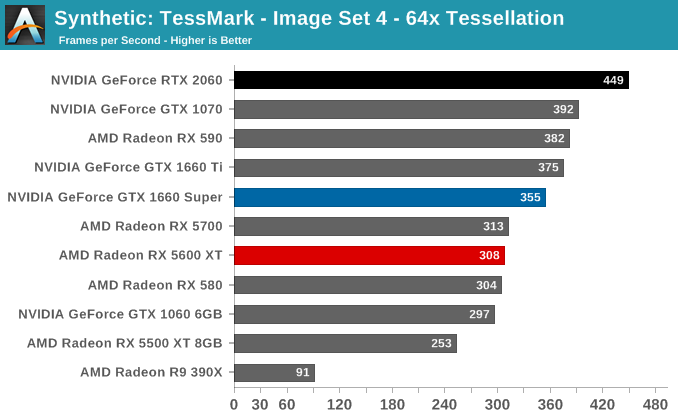
Given the significance of cutting a quarter of Navi 10’s GDDR6 memory bus, I was very curious to see what that would do for synthetic performance. But for better or worse, this has created more questions than it has solved.
The numbers listed below are accurate, in as much as these are the results I get when testing these cards. Whether they are correct, however, is another matter.
The problem, in short, is that due to AMD’s very aggressive power savings/idling implementation for their Navi 10 cards, I have been unable to get these cards to run at their full memory clockspeeds when executing the the Beyond3D Suite benchmark suite. The GPU clocks regularly pass 1600MHz like they should, however AMD’s telemetry is reporting that memory clocks are rarely hitting 7Gbps, let alone 12Gbps+. As a result, we end up with results like the pixel test below, where the RX 5600 XT is beating the RX 5700, an otherwise impossible outcome.
As best as I can tell, this issue has been going on since the launch of the Radeon RX 5700 series back in July, but it’s only now that I’ve noticed it, in large part due to the RX 5600 XT cards being slightly less aggressive in their idling. In other words, those cards are boosting to higher memory clockspeeds more often, putting them ahead of the RX 5700 and bringing the clocking issue front and center.
I’m still working on a proper fix for the issue, but for now the results with Navi 10 cards should be taken with a large grain of salt. The benchmark itself is still fine, but AMD’s aggressive power management (and lack of an easy means to disable it) is kneecapping AMD’s performance in these benchmarks.
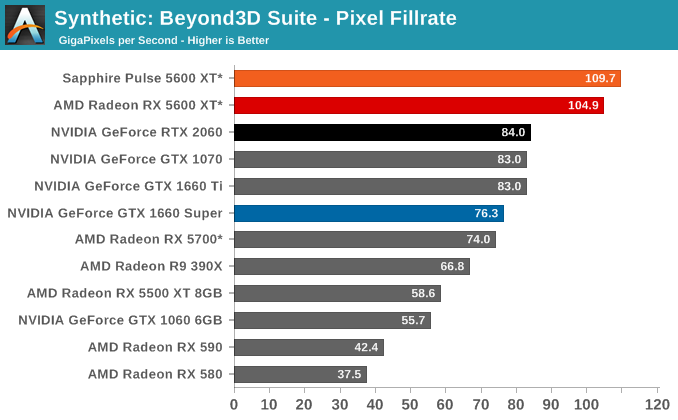

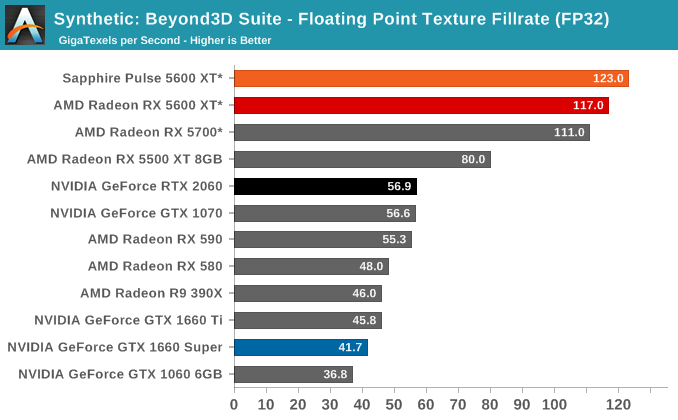
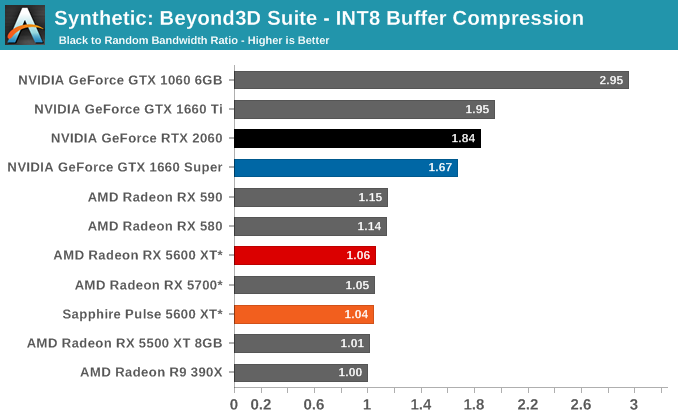
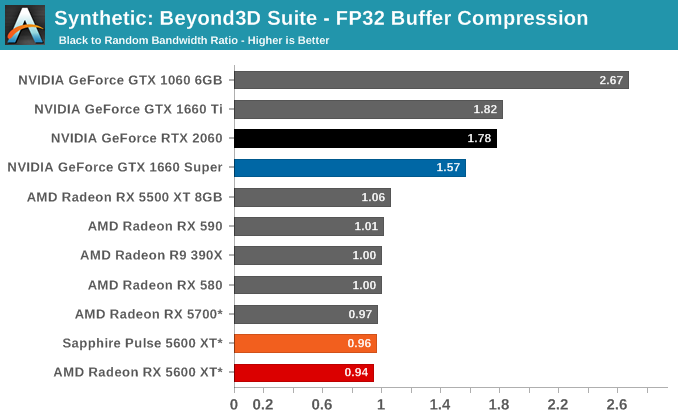










202 Comments
View All Comments
Korguz - Friday, January 24, 2020 - link
more hare from cmdrmonkey....sorry man.. but nvidias drivers.. arent as perfect as your anti amd bias thinks
Korguz - Friday, January 24, 2020 - link
hare = hateSpunjji - Thursday, January 30, 2020 - link
If argument fails due to blatant dishonesty then redirect to boilerplate FUD.Farewell, goalposts; I hardly knew ye.
desmonds99 - Thursday, January 23, 2020 - link
AMD just overclocked the card themselves so reviewers would use this as a baseline to compare with other non-oc cards, making the card more appealing instead of DOA at $279. Once other cards are overclocked the price/perf will be the same as its competitors. AMD is just filling the gap for their lineup. $249 would be a more competitive price imo.Yojimbo - Monday, January 27, 2020 - link
Yeah. There was too much trust by reviewers on this situation. Some warning lights should have gone off. I don't know if it happened due to worry about access or if reviewers have something personal at stake.Will a buyer be able to flash? Will he get 14 Gbps memory if he does? Will the card have reduced reliability after the flash? And the problem doesn't go away after launch. 6 months from now someone can read this review thinking it is representative of the 5600 XT when there are cards out there that run over 10% slower. So what is the true price point of the cards that you can get that are validated to run at the benchmarked performance levels? Of course there will be a delta in the market, whether it becomes 160 to 180 or 180 to 200. That can give a completely different conclusion about the card, even ignoring the Busch league je-jiggering and the confusion it creates.
PProchnow - Monday, January 27, 2020 - link
The 5700XT is cranking over 2000Mhz and it is about tie AMD does this simple trick to make the GPU put out a little more.In this highly affluent world NO ONE will want a 5600XT unless they are little teenage paper route boys in high crime areas. $100 above the 5600XT lies a top end competitive card.
I understand these manufactures get a few lesser cores from the GPU chip foundary and pop them in the second tier cards that are $100 less than the GOLDEN SAMPLE GPU cards.
That is about all I need to know.
I do it on a GTX1080 and a R9 Fury clocked to 1100Mhz with more RAM bandwidth than the GTX [RTX?} ---- both plans to perform wotk. I hope for more HBM ram to get tied into the priemier performance video card. How could that tech turn into a side stepable meadow pie? Shame!
Yojimbo - Tuesday, January 28, 2020 - link
It's expensive. The fact that AMD needed to use it is one reason their high end cards were not very competitive. Maybe eventually its cost will come down. It is a very important technology in the HPC segments where bandwidth is a lot more important, though, so it's not a meadow pie.Spunjji - Thursday, January 30, 2020 - link
"In this highly affluent world NO ONE will want a 5600XT unless they are little teenage paper route boys in high crime areas. $100 above the 5600XT lies a top end competitive card."I'mma guess that you're the sort of person who laughs when someone says "check your privilege"...
Yojimbo - Thursday, January 30, 2020 - link
Since when are people talking about financial situations when they say "check your privilege"?PProchnow - Friday, February 7, 2020 - link
Gimme BIG NAVI!6,000 cores [ or EUs or CUDA Cores] at 3Mhz and 16GB HBM (equiv. 32GB reg Ram)
@7NM ONLY CONSUMING 150w. - cracking the 100% mark, AND PRICED AT $375USD.
I do not care if they call it the 5950XTX OC Super...LOL!